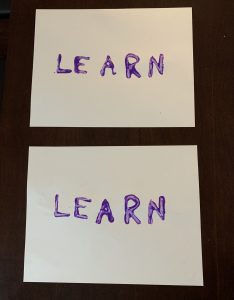

I approached this task reluctantly as I am definitely not the “crafty” type. I don’t have a Pinterest account, and am convinced I don’t have an artistic bone in my body. I was intrigued, however, by the prospect of what I might learn, so I decided to go ahead with the potato stamp adventure.
I watched the DIY clip and was surprised at how easy it was to carve the letters into the potatoes. After practicing for about 15 minutes, it took me about 5 minutes per letter. Once I had my word completed, I proudly painted my first letter (the letter L), placed the stamp onto the paper, and then felt like I was part of a practical joke. How could I not have realized the letters needed to be backwards?? I laughed out loud and considered myself fortunate that the E and A did not have to be redone. I then spent another 15 minutes re-doing the other 3 letters. So in total the process took about an hour. I did have a fairly easy time reproducing the word twice, although the potato was very delicate. When I think about how many words there are in the English language, and how long it took me to make 1 simple 5 letter word, it is astounding to think how painstaking it must have been to copy manuscripts by hand and work with some of these early text technologies.
This assignment also made me think about the limitations of the earliest versions of the printing press. I intentionally selected a word with only one circular letter (R), because I knew it would be easier to carve straight lines (although I also thought the word LEARN was appropriate for the assignment). I can imagine that this also challenged the earliest technicians creating letters out of wood, and how this would likely have been far less of an issue when wood was replaced by the metal molds used in moveable type. As well, like wood, I can tell the potato would not be very durable.
The evidence is clear that the printing press did indeed “change the pattern of literacy,” (Harris, 2017) and this assignment really brings that concept to life. When printed materials became more available an entire world was unlocked. The length of time it took to make the potato stamps to record a single word reflects how this historic change required the invention of a technology to increase the speed at which information could be produced and shared. I also thought about David Hume’s observation that new printing technologies didn’t just make knowledge more accessible, they made it easier to improve and correct work (Harris, 2017). When I realized I had made a mistake with my letters, it required carving out new letters, which is time consuming and frankly, annoying. The advent of the printing press allowed documents to be changed and adapted so much more easily, with future editions reflecting new opinions and discoveries. This encouraged authors of these early works to strive to include the most up to date knowledge, to the benefit of society.
Overall this was a thought-provoking experiment which helped me “LEARN” more about text and technology!
References
Harris, Bradford. (2017). The printed book: opening the floodgates of knowledge [Audio podcast episode]. In How It Began: History of the Modern World . Retrieved from https://howitbegan.com/episodes/the-printed-book/

Yes, I had a gas too . . . but my results were still far inferior to yours! Well done.
Megs K.
Thank you! I’ll have to check yours out as well!
It was frustrating having to redo letters. I think the labour intensiveness of it lets us really appreciate the creation of all of the letters for the first printing press but well worth the effort. Being able to create more than one copy at a time and to make it available to the masses really advanced literacy and, as you point out, so much easier to edit. This in turn makes me think about how much easier it is to edit a typed passage on a computer or mobile devices. How is this changing our world? (Less capitalization for my students for one and more text speak).
Hi Rebecca,
Totally agree that technology is impacting how students communicate by text. I think this is something we will likely investigating in upcoming weeks, so perhaps it is a discussion we can continue then! Thanks for your response.
Helen
So funny to hear you don’t think of yourself as artsy or creative!! One thing that really struck me about reviewing your 590 portfolio was how stylish it was and how the layout, colours, and images added emotion to your work by connecting your artifacts in an artistic way.
You are too kind! I really struggled with that aspect of the 590 portfolio, although I did enjoy playing around with the different layout options. I think I have a narrow view of what it means to be artistic…I think I prefer the digital world rather than creating art with my hands.
Hi Helen! I think you did an amazing job and should take more credit for your craftiness! It’s funny how differently we see ourselves vs how others see us as we all think you did great!
As for the backwards potato printing error – I think I would have done the exact same thing, even though I use stamps on practically a daily basis with my kids. I’m sure I knew that they are backwards but when faced with a task such as this I don’t think that I would make that connection. I wonder how many newspaper headlines were misprinted back in the day using the printing press with metal letter moulds? While I couldn’t find any old newspapers online I did find this incredible article by the Guardian which I think you might like.
https://www.theguardian.com/gnm-archive/gallery/2016/nov/18/making-headlines-printing-the-guardian-newspaper-1921-1987-in-picures
Hi Sasha,
Great article! Those are some amazing pictures. Thanks for sharing!